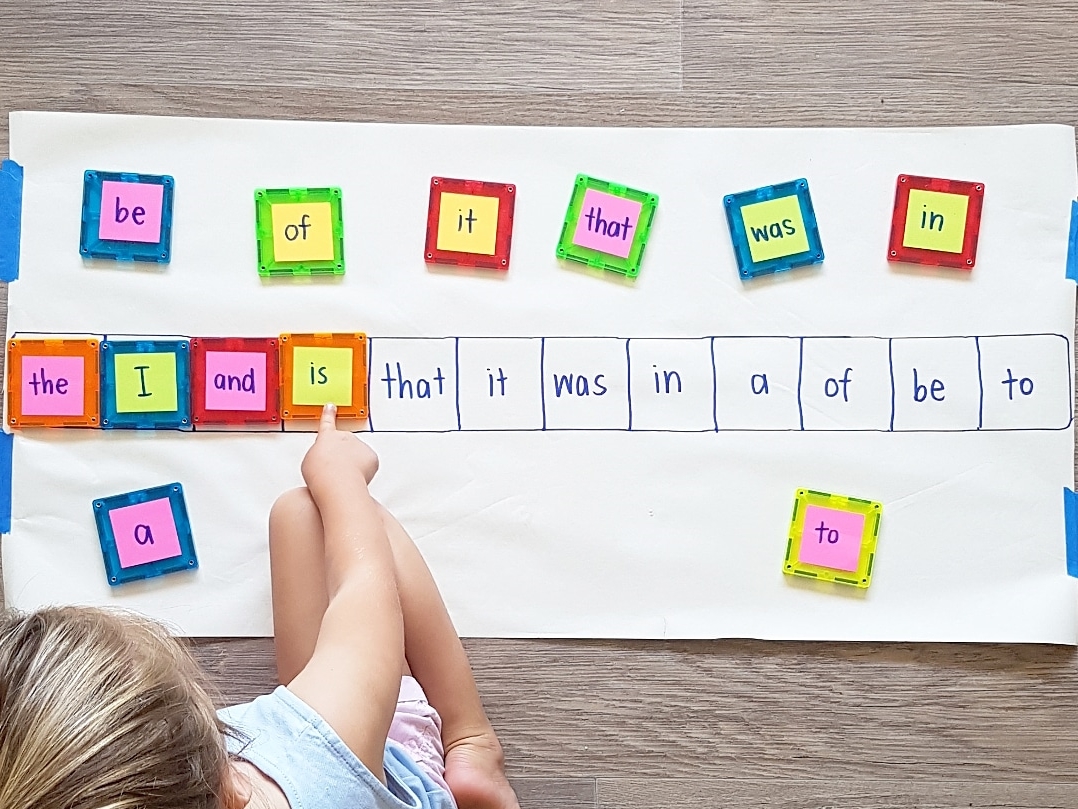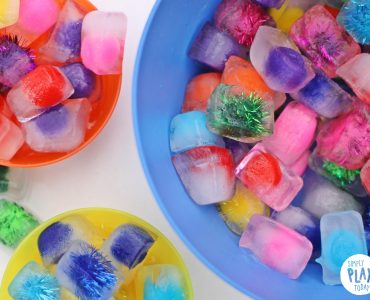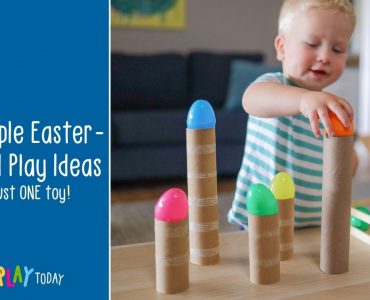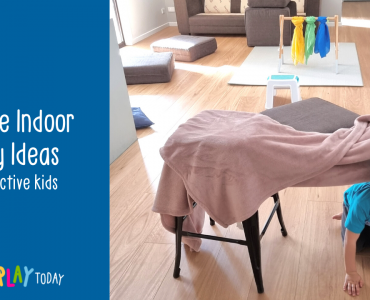This post was first published 18/3/19 on my original website thepaigediaries.com
As I sit here writing this blog post, it still blows my mind that Miss Paige started school this year. Like, seriously, where on earth have the last five years gone??!
And as most of you with school-aged little ones (or not so little ones anymore!) would know, starting school generally comes with some sort of ‘homework’ to do at home, whether that’s reading, practising sounds or practising sight words.
For Paige this term, it’s an expectation that she does regular sight word practice at home. And that doesn’t necessarily mean daily, but of course the more she practices, the more confident she will become at recognising those sight words.
But the teacher in me was well aware that going through a set of flashcards every night wasn’t going to cut it! Sooner or later, she would get bored and she would lose interest, and then all of a sudden what was once super exciting becomes a chore.
So, what did I do? I came up with a whole heap of sight word games and activities that we could do together, which would keep the learning FUN!

This post contains affiliate links at no extra cost to you.
Please see our disclosure for full details.
But first, let’s chat about what a sight word actually is!
A sight word is a word commonly found in written text, that usually doesn’t follow regular spelling rules and patterns so are best learned to recognise by sight, rather than sounding out. The larger the bank of sight words that your child can recognise instantly, the easier it is going to be for them when they begin reading.
Sight words are usually explicitly taught to your child when they begin school, and practising these words at home may be part of their homework. Sight words are generally taught by rote learning – that is repetition which leads to memorising, and the most common way to do this? Flashcards.
Like I said earlier, I realised pretty quickly I realised pretty quickly that going through a set of flashcards each night was NOT going to keep Paige engaged in learning these words, so I began finding new and interesting ways to make learning them fun!
And as I did these activities at home with Paige I started sharing them on my Instagram page (along with the sight words games I do as part my Literacy rotations with my Reception class at school) a LOT of you said you wanted more! So, I’ve come up with a range of sight word games that will hopefully engage your little one and keep learning FUN!
So, here we go!
Mess Free Ideas
Now, if you’ve been following me for a while, you will probably be well aware of my love for sensory play! And of course, when it comes to learning, you would have probably figured out by now that there was going to be some sensory play ideas included in this post. BUT the truth is, I actually don’t have the time or energy to do those types of activities every day. So first up, I’m sharing some ideas that are completely MESS FREE! #CanIGetAnAmen
Sight Word Tower


I stuck a piece of tape onto the side of Duplo blocks and wrote Paige’s sight words with permanent texta on the tape. I then challenged Paige to build a tower with the blocks and once she was finished asked her to read the words on her tower.
By using different shaped and sized blocks, not only did Paige enjoy the challenge of making sure the tower was stable, but it also made a simple and engaging STEM activity as well!
I have seen this done by writing directly onto the blocks, but I prefer this way as I can peel off the tape once we are finished, plus it also gives me the opportunity to change the words on the blocks as Paige learns each set of sight words.
Magnetic Tile Match

This activity was TOTALLY inspired by this activity from Beth @dayswithgrey who used this with her son to practice name recognition. When I saw it I knew it would make a great sight word activity for Paige because she loves using our Playmager magnetic blocks!
I wrote each sight word onto a mini Post-It Note and stuck them all to the magnetic blocks. Then I rolled out some paper, lined the blocks up, traced them and wrote the words in each square. Paige’s job was to start at the left (to encourage left to write progression which is how we read), say the word, find the matching block and put it on top. The click of the tiles as they snapped together made it that bit more exciting too!
Sight Word Search

Something really important to keep in mind when learning to recognise sight words is that the child should be able to recognise them in different contexts, and not just the flashcards or memo book they come home from school in. One really important context that children need to see sight words is in written texts such as picture books. Some nights Paige’s sight word practice consists of looking through books and finding her sight words within the text. This is really exciting for Paige as she feels such a sense of achievement that she is actually reading!
I’ve also done this as an independent activity at school during our Guided Reading rotations – I provide each student with a sheet of paper that has their sight words written in a grid, and as they look through books and find their sight words they colour in the corresponding word on their paper. Their challenge is to have all of their words coloured in before the end of that rotation. It’s a wonderful way to encourage reading words in books rather than just looking at the pictures.
Another way I’ve encouraged sight word recognition in books is by reading stories with Paige – I point to each word as I read, and when I get to one of Paige’s sight words I pause and let Paige read that word. To her, being able to join in with the reading is the Best. Thing. EVER!
Tic Tac Toe
Tic Tac Toe a simple game that I first learned at the school I teach at now, and is a real winner because it only uses the flashcards which we get from school, so requires absolutely ZERO prep on my part at home! It’s also perfect to use with small groups of children, so great for the classroom!
To begin, lay all the cards face down on the floor or table, then one person chants ‘Tic, tac, toe, tic, tac, toe, where I land I do not know!’ while pointing to a different card for each word they say. They flip over the card they land on and read it aloud. If they correctly identify the word, they get to keep the card, and if not the card goes back with the others. Then the next person has a turn, and it continues until all cards have been flipped over.
Across the River

This is another simple activity that requires zero prep (as long as you have flashcards!). Space the cards out in a long line with the words facing up, then challenge your child to start at one end of the ‘river’, jump on the first word and say it, then jump to the second word and read that one, and continue all the way across the river! This game is perfect for children who have endless amounts of energy, or who love to move while they learn!
Build A Word

We got Paige these Coko letter blocks for her birthday and they have been another wonderful tactile way to include sight word practice each night! As the focus for her at the moment is to recognise the words (rather than spell them – they are two very different skills!!), I have been building the words on our Duplo base and Paige has read them back to me. As she becomes more confident with these words, I imagine she will begin to try and build them herself, but like I said, reading the words and spelling the words are two different skills, and for the time being her focus is just recognising the words by sight.
Sight Word Post

This activity came about only because Paige was really reluctant to do anything with her sight words the other night. So I just asked her to post them in our wooden post box (similar to this one), which happened to be sitting in the lounge room, and asked her say the words as she posted them. Well, that was enough for her to post those words about three times over, saying each one as she went! #Winning!
Of course, if you don’t have a toy mailbox, you could always make a simple one by cutting a slot in a shoe box or any other box you have in the recycling!
Sensory Play Ideas
And now for the sensory play ideas!! Be aware that these ideas do take a bit more prep time than the others, but are honestly well worth it!
Magnetic Counter Search

This game didn’t actually interest Paige at first, until she saw Samuel using the magnetic wand to find the little counters, then of course wanted to get involved! I stuck pieces of tape to metal rimmed counters and wrote the sight words on each one. Then I tipped them into a container of rice for Paige to find using the magnetic wand. You could also play a similar game by sliding paperclips onto the flashcards and fishing for them with magnetic fishing rods!
Sight Word Search
Another activity that you could do with that same tub of rice is hide all the flashcards in the rice, then encourage your child to pull one out at time, read it, then hide it back in the rice. They will enjoy getting their hands in the rice, and you’ll love how easy it is to set up! You could also include a pair of jumbo tweezers or tongs to work on hand strength!
Sight Word Reveal

I shared this activity on my Instagram page earlier in the week and it got a GREAT response! I used a white crayon to write the sight words onto white paper, then encouraged Paige to use our watercolour paints to find all of the words! She loved seeing the words appear on the paper, and again said each word as it was revealed, meaning she was practising those words without even realising!!
Kinetic Sand Stamping

As you child is learning to identify sight words, you can use puzzle pieces like these from this Hape puzzle to stamp your child’s sight words into the kinetic sand for them to identify. As they become more confident, they may begin to stamp their own words – but again, don’t rush this as it is much more difficult that recognising them by sight! Playdough makes a great alternative if you don’t have kinetic sand!
Ball Scoop

I’ve do this activity regularly at school and my goodness, do the kids love it or what?! To set up, I give each student a laminated sheet with their sight words in a grid, then I’ve written each sight word onto ping pong balls which I tip into a big container of water. Students used scoopers similar to these to catch a ball, read the word, then put a counter on the corresponding word on their sheet. Again, their challenge is to catch all the different sight words before their rotation time is finished. A spoon would also make a great alternative if you don’t have the plastic scoopers at home.
Find A Word


We absolutely LOVE rainbow rice and I’m always thinking up new ways to play with our huge stash! To prepare this activity I wrote sight words around a piece of paper, stuck it in a baking tray (any tray would work!) then covered the paper with a thin layer of rice, so all the words were hidden. Paige used a paint brush to uncover and read each word, which she thought was SO MUCH FUN!
Outdoor Ideas
Now, most of the activities I’ve already shared are able to be done outside if you’re child enjoys being outdoors, but here are a couple more activities that are great for playing outside!
Word Jump

Write the sight words with chalk on the ground outside (concrete works best), then call out a word and have your child run and jump on it! You can also call out certain actions for your child to complete on each word, for example Do six star jumps on ‘that’ or Crawl like a crab to ‘and’.
You could also play ‘Across the River’ by writing the words in a long line for your child to jump across.
Word Spray
The lucky last activity that I’m sharing on this post is another fun activity, perfect for outside! Write the sight words on an outside wall with chalk, then hand your child a spray bottle, call out a word and let your child spray the word with water! Super easy, and super fun!
And there you have it! Enough sight word practice inspiration to keep your little one engaged with practising their sight words each day!
Now I just wanted to share a quick reminder that I think as parents we sometimes forget.
There will be days when our little ones are just NOT in the mood for homework like practicing their sight words, even if it is as part of a game!
We want learning to be fun for our children, so on the occasional day when they’re just not feeling it, don’t push it.
Don’t make it a chore.
Don’t make it unenjoyable.
Leave it and try again the next day.
Even our school-aged kids need unstructured time each day, whether that’s riding their bike, playing inside, drawing, or helping you with dinner. They might not be learning their sight words, or practicing their reading or their spelling words, but I promise you, when we give our children unstructured time, they will still be learning about the world around them. And that’s just as important as learning sight words.
So let them PLAY.
Lycie xx





